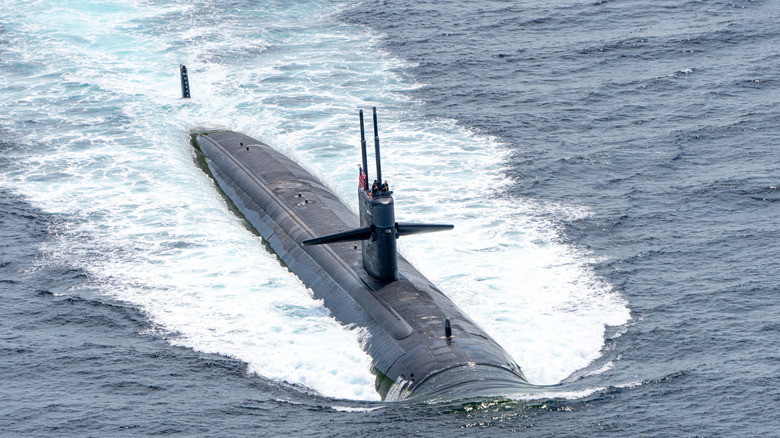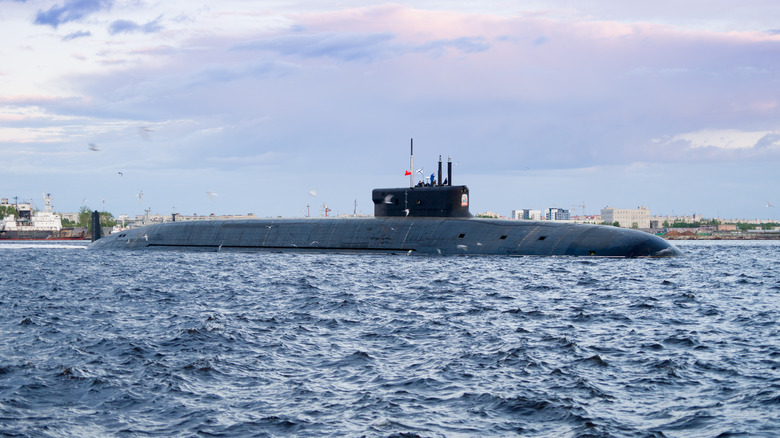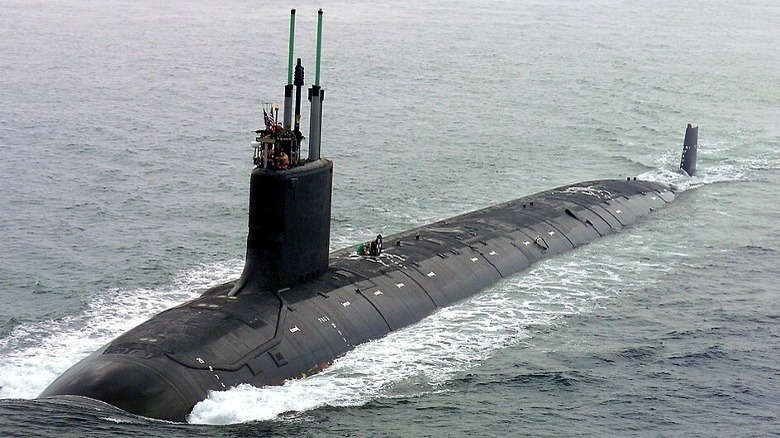5 Of The Most Advanced Nuclear Submarines In The World
Nuclear submarines are the latest in monumentally advanced technology powering global military forces. Throughout the entire world, there are only nine nations that have developed nuclear weapons. Of these, only six use nuclear technology in submarine propulsion as of 2023 — the U.S., China, Russia, France, India, and England.
Nuclear submarines are technologically superior to traditionally powered vessels in many ways. A nuclear submarine can remain submerged for months, allowing for lengthy reconnaissance or pre-attack planning missions that other submerged vessels simply can't accommodate. Estimates suggest that they could stay beneath the surf for 20 years if not for the need to take on supplies like food for the crew. This makes them an invaluable tool in global sea power operations. These vessels can achieve higher speeds than traditional submarines, adding to their utility in any potential conflict. However, nuclear submarines are generally louder than other submerged ships because of the constant engagement of the ship's reactor. They are also larger and less agile than traditional vessels. As a result, navies that employ nuclear submarines continue to support non-nuclear alternatives to maintain combat readiness under many unique circumstances.
Nuclear submarines are a true engineering marvel, but some builds stand head and shoulders above the rest. These are the most impressive and advanced nuclear submarines in use today.
Russian Borei-A-class submarines
In 2022 the Russian Navy sailed a new Borei-A-class submarine into the White Sea to begin factory trials of its latest addition. The "Generalissimus Suvorov" SSBN is a fourth-generation nuclear-powered submarine and was slated to enter service in the Pacific Fleet by the end of 2022. This vessel is the third Borei-A submarine delivered to the Russian Navy, after "Knyaz Vladimir" in 2020 and "Knyaz Oleg" in 2021.
The platform is an improved template over the previous Borei-class design that includes enhanced stealth capabilities (through quieter operation) and deep-sea maneuverability. These vessels are typically armed with 16 intercontinental ballistic missiles (SLBMs) and 553mm torpedoes. A Norwegian outlet, The Barents Observer, reported on December 29, 2022, that the "Generalissimus Suvorov" had indeed been folded into Russia's Pacific Fleet in a dedication ceremony on that day and would carry missiles armed with nuclear warheads rather than traditional explosive munitions.
The submarine's SLBMs are capable of striking targets at a distance of 6,200 miles, and the vessels are also armed with roughly eight MIRVs (Multiple Independently-targetable Reentry Vehicle) that can facilitate the launch of multiple warheads at a time–with each focused on independent targets.
American Virginia-class submarines
Virginia-class fast attack submarines are some of the newest vessels in the U.S. Navy's arsenal. The contract to build a new propulsion platform was awarded to Babcock & Wilcox Nuclear Operations in 2013, and the subs themselves have been assembled in Newport News, Virginia, by Huntington Ingalls Industries and General Dynamics Electric Boat. Today there are 21 active Virginia-class vessels in service. The attack submarines are nuclear-powered, and the first of the series, the "Virginia," was commissioned in 2004.
These submarines are slated to replace the existing Los Angeles-class submarines with retirements and new commissions scheduled over the coming years. This gives operators in Virginia-class vessels a distinct advantage when it comes to interdiction and surveillance operations conducted in hostile waterways.
Virginia-class submarines are armed with Tomahawk missiles and MK48 ADCAP torpedoes. The vessels can reach a speed of over 25 knots and are particularly well-versed in conducting shallow-water operations. One unique feature of these submarines is the reconfigurable torpedo room. This space can act as a staging and deployment area for special operations teams on long deployments, and the submarines provide a lock-in/lock-out chamber to allow divers to enter and leave the vessel without having to surface.
[Featured image by U.S. Navy via Wikimedia Commons | Cropped and scaled | Public Domain]
The British Royal Navy's Vanguard-class submarines
The United Kingdom launched the HMS Vanguard in 1993, and in the years since four Vanguard-class submarines have acted as the nation's primary undersea patrol vessel. Vanguard-class submarines are powered by nuclear reactors and offer ballistic missile engagement options. These vessels are one of the U.K.'s primary nuclear deterrents and are therefore equipped with nuclear warheads.
Vanguard-class submarines carry 16 Trident II D5 missiles with as many as 12 MIRV warheads (resulting in up to 192 individual nuclear munitions). The vessels operate four torpedo tubes and carry Spearfish torpedos for underwater or surface combat requirements. The submarines can reach a speed of around 25 knots, placing them squarely within competitive standards with other nuclear submarines that traverse the depths of the Earth's oceans.
While the Vanguard-class submarines are a critical piece of the United Kingdom's defensive backbone, the newest of the four vessels was commissioned in 1999, some 20-plus years ago. In contrast, the United States, Russia, and others are rolling out new vessels to handle deterrence and submerged surveillance tasks. For its part, the British Government is pursuing the development of new submarine technology and intends to replace these four Vanguard-class vessels with the new Dreadnought class by the 2030s.
The Suffren, France's first Barracuda-class attack submarine
In June 2022, the French Navy introduced a new Barracuda-class vessel to its submarine fleet. The "Suffren" is the first of six to enter service over the coming years and can dive below 350 meters (1,150 feet) for 70-day missions. The vessel is small compared to others of this type (99 meters long, or 325 feet), and it's packed full of technology that helps the crew remain silent in the water and deadly when necessary.
The ship is armed with cruise missiles that can be launched via the sub's torpedo tubes, wire-guided torpedos, anti-ship projectiles, and mines. The vessel is also outfitted with the ability to support special operations groups, with a dry deck shelter that facilitates the deployment of combat swimmers and submersible vehicles.
The Barracuda-class submarine lineup will replace France's Le Triomphant-class vessels. Many of the weapons systems are similar to the previous generation. With a larger footprint, a 60-day mission window, and a fleet of only four ships, the Barracuda class is a much-improved asset in French intelligence gathering operations, deterrence, and forward strike capabilities.
[Featured image by Xavier Grolet via Wikimedia Commons | Cropped and scaled | CC BY-SA 4.0]
The American Ohio-class submarine
The Ohio-class submarine stands tall above the competition regarding advanced nuclear submarines. The 14 remaining Ohio-class ballistic missile vessels (and four converted guided missile submarines) are the largest submarines deployed by the U.S. Navy. They typically patrol on 70-day deployments but can remain submerged for as long as necessary (limited only by food and other material requirements of the crew). Approaching crush depth, Ohio-class submarines are noted as capable of diving to around 800 feet but have been known to achieve depths below 1,500 feet.
These vessels can achieve speeds rising above 30 knots and carry up to 154 Tomahawk missiles, as well as Trident II D-5 nuclear armaments that offer an estimated range of around 6,500 nautical miles and as many as 12 warheads per missile. The resulting arms capacity is potentially hundreds of nuclear weapons that can travel across the hemisphere they're fired from. The submarines also pack a punch underwater, with Mk48 torpedoes and four torpedo tubes for attacking surface ships and other submerged vessels. This led Popular Mechanics to call the Ohio-class submarine "arguably the most destructive weapons on the planet."
[Featured image by U.S. Navy via Wikimedia Commons | Cropped and scaled | Public Domain]





